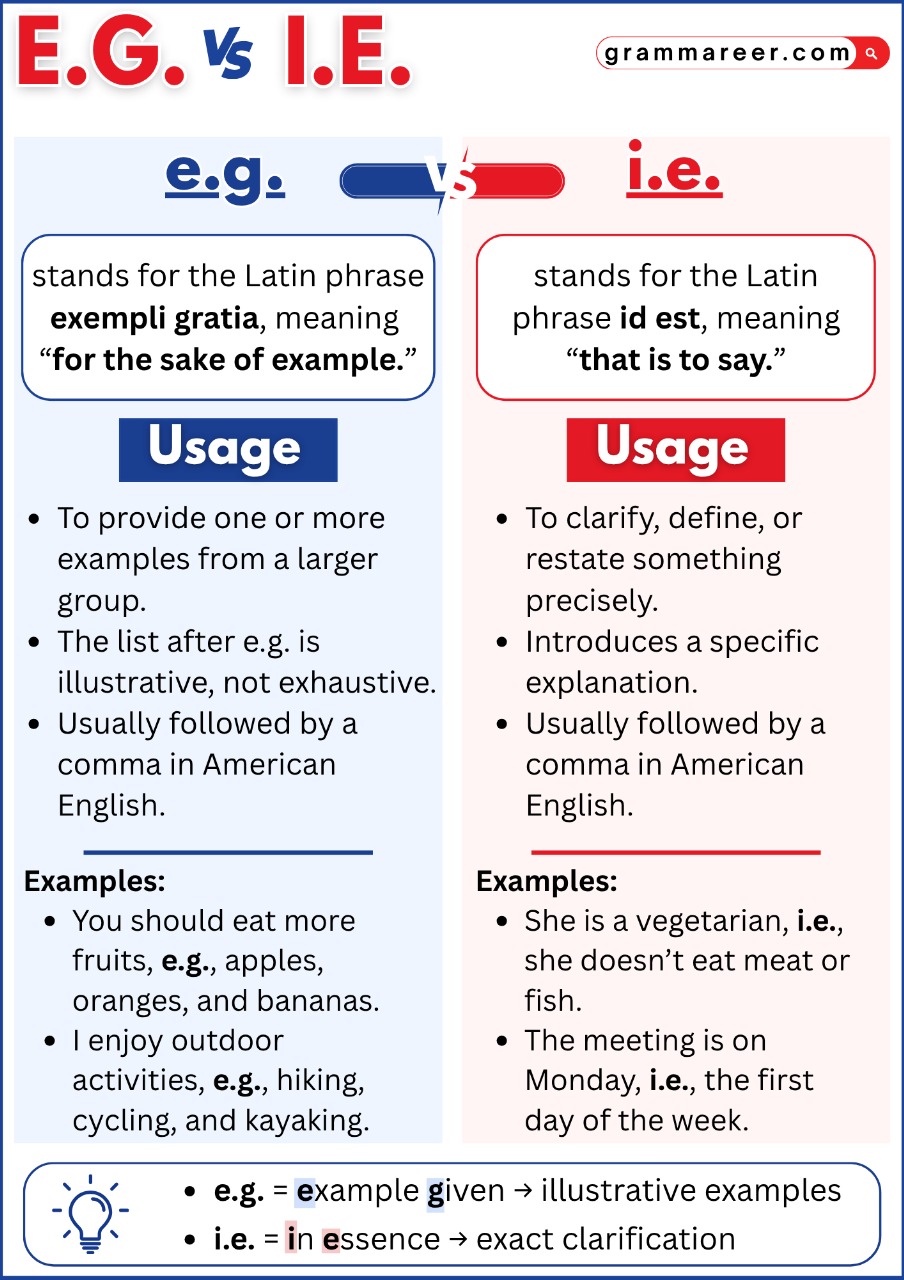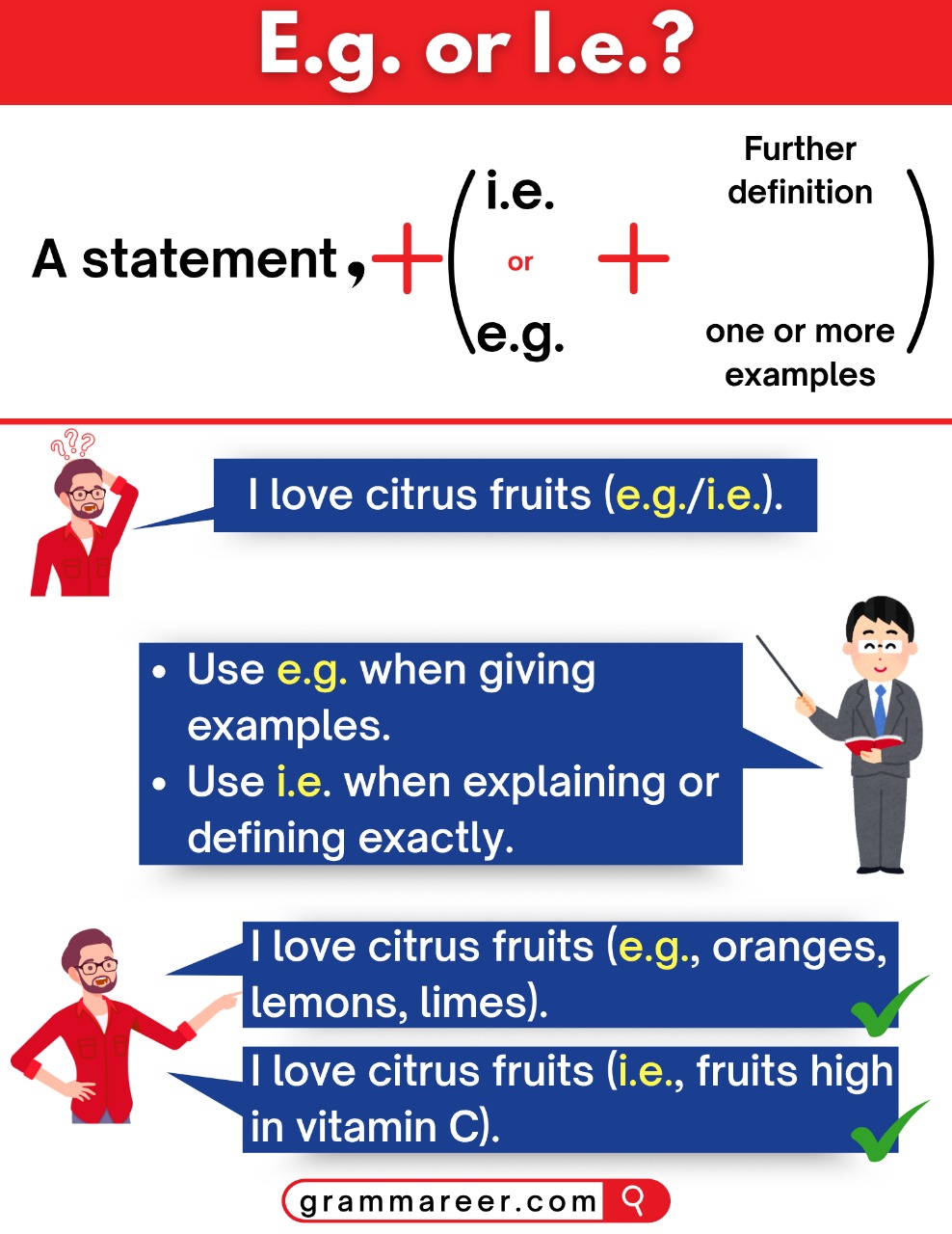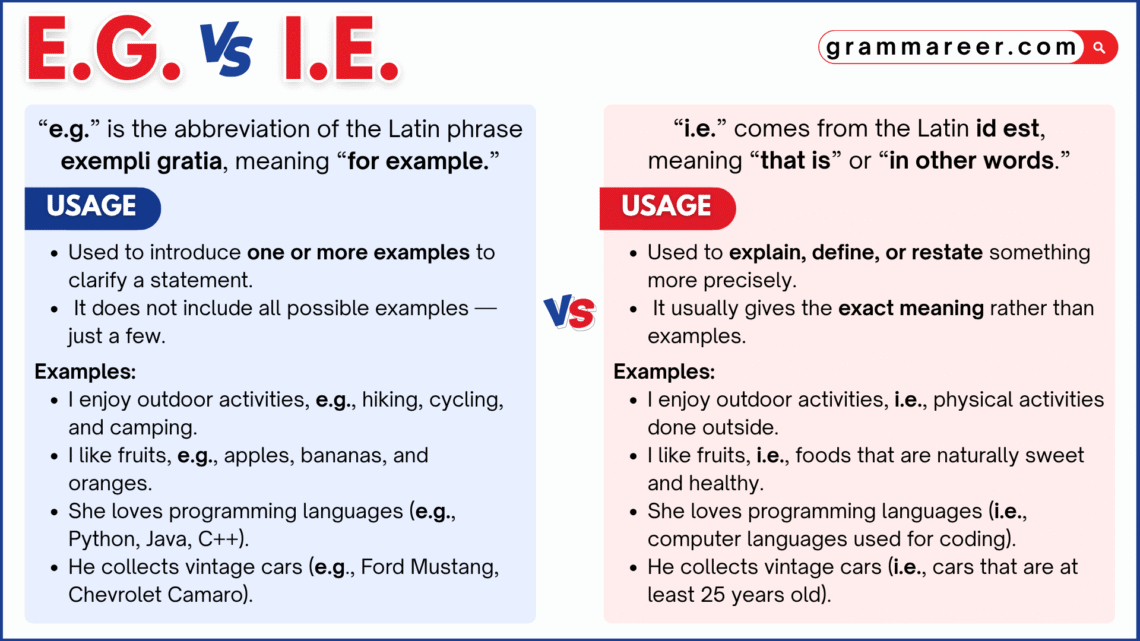If you’ve ever paused while writing and wondered whether to use i.e. or e.g., you’re not alone. These short Latin abbreviations often appear in books, articles, and even casual messages, yet they still confuse many learners. Each has a different meaning and purpose that can completely change a sentence.
In this article, you’ll know exactly what each one means, what is the difference between i.e. and e.g. and how to use them the right way in your own sentences.
Table of Contents
What Does e.g. Mean?
The abbreviation e.g. comes from the Latin phrase exempli gratia, which means for example. We use it when we want to give one or more examples to explain an idea clearly.
Example:
- We read many famous novels by Dan Brown, e.g., Angels and Demons, The Da Vinci Code, and Inferno.
- Many people think e.g. stands for example given, but that’s not actually true. Still, it’s a helpful trick to remember that e.g. is used before giving examples.
So, whenever you want to say for example, you can use e.g. instead.
How to Use e.g. in a Sentence?
Using e.g. correctly is mostly about punctuation and placement. You can include it inside parentheses or directly in your sentence. Both ways are fine.
Examples:
- We’re planning a few fun activities (e.g., hiking, swimming, and cycling).
- My coach taught me some new exercises, e.g., squats, lunges, and push-ups.
Remember these rules:
- Always put a period after each letter (e.g. not eg).
- Always put a comma after e.g.
- If it’s inside parentheses, you don’t need a comma before it.
Example:
- I love baking (e.g., cakes, cookies, and muffins).
- I love baking, e.g., cakes, cookies, and muffins.
Different style guides may have small punctuation differences, but these rules work perfectly for most everyday writing.
What Does i.e. Mean?
The abbreviation i.e. comes from the Latin phrase id est, which means that is or in other words. We use it when we want to explain something more clearly or restate an idea in a simpler way.
Example:
- We find peace in small things, i.e., cleaning our space and organizing our books.
So, while e.g. gives examples, i.e. helps us clarify what we mean. An easy way to remember this is to think of i.e. as saying in other words.
How to Use i.e. in a Sentence?
Using i.e. is quite simple once we understand its purpose. We can use it inside parentheses or directly in a sentence.
Example:
- He always remembers the little details (i.e., how we like our tea and snacks).
- He always remembers the little details, i.e., how we like our tea and snacks.
Here are a few things we should keep in mind:
- Always write i.e. with periods after each letter.
- Always place a comma after i.e.
- If we use it inside parentheses, we don’t need a comma before it.
Example:
- We discussed our favorite subjects (i.e., English, history, and science).
- We discussed our favorite subjects, i.e., English, history, and science.
Also remember that i.e. and e.g. are always lowercase and don’t need italics in regular writing.

Difference Between i.e. and e.g.
We often come across i.e. and e.g. in writing, and it’s easy to mix them up. The main difference is in what they do for a sentence. i.e. is used to explain or clarify something we just said, while e.g. is used to give one or more examples of it.
Example of i.e:
- We decided to visit a quiet place (i.e., a small cabin by the lake).
Here, i.e. is helping us explain exactly what we mean by a quiet place. It gives more context and makes the sentence clearer.
Example of e.g:
- We decided to visit a quiet place (e.g., a cabin by the lake, a small guesthouse in the mountains, or a cottage in the forest).
Here, e.g. is giving a few examples of quiet places we might choose. It helps the reader understand our idea by showing options.
When we compare the two, it becomes easy to see the difference. i.e. is like saying in other words, while e.g. is like saying for example. Both make our writing stronger and easier to understand, and using them correctly shows that we know how to explain our ideas clearly.

Punctuation and formatting with e.g. and i.e.
Now that we know what e.g. and i.e. mean and how to use them, it’s important to get the punctuation right so our writing stays clear and easy to understand.
In US English, we usually put a comma after e.g. and i.e.. In other varieties of English, like UK, Canadian, or Australian English, this comma is often left out. One thing to keep in mind is that we don’t need a comma before these abbreviations if they are inside parentheses.
Both e.g. and i.e. almost always have a period after each letter. We don’t need to italicize them unless a specific style guide asks for it. This keeps the writing simple and easy to read.
Sometimes, we might wonder if we can start a sentence with e.g. or i.e.. Technically, we can, and we should capitalize the first letter. However, it often sounds smoother if we rephrase the sentence.
Examples Using i.e. and e.g.
- My favorite fruit is citrus, i.e., oranges, lemons, and limes.
- Famous painters, e.g., Van Gogh, Picasso, and Monet, have inspired generations.
- The meeting will take place in the main conference room, i.e., the one next to the lobby.
- I enjoy outdoor hobbies, e.g., hiking, kayaking, and gardening.
- Our team focuses on social media marketing, i.e., creating content, managing posts, and tracking analytics.
- Popular fast foods, e.g., burgers, pizza, and tacos, are often high in calories.
- Several programming languages are in demand, e.g., Python, JavaScript, and Java.
- I prefer writing in digital notebooks, i.e., apps like Evernote and Notion.
- The final exam covers the core subjects, i.e., math, science, and English.
You May Also Like

